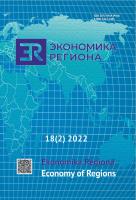Классификация межсистемных аварий на инфраструктурно сложных территориях
Classification of Intersystem Accidents in Infrastructure-Complex Territories
Author(s): Valery Vitalyevich Lesnykh, Tatiana B. TimofeevaSubject(s): Economy, Geography, Regional studies, Rural and urban sociology
Published by: Институт экономики Уральского отделения Российской академии наук
Keywords: urbanisation; infrastructure-complex territories; critical infrastructures; life support systems; intersystem accidents; negative consequences; damage from accidents; resilience;
Summary/Abstract: Urbanisation led to the establishment of infrastructure-complex territories (ICTs). The growing interaction between critical infrastructures in such territories, combined with an increase in the frequency and scale of natural disasters, caused a surge in intersystem accidents (ISA). ISAs are characterised by cascading processes and catastrophic consequences for regional socio-economic development, since they affect both the critical infrastructure and environment. The paper aims to classify intersystem accidents in infrastructure-complex territories, as well as to assess the adaptive resilience of these areas to external influences. An examination of available statistics on domestic and foreign intersystem accidents demonstrated the importance of the issue and allowed us to identify common features of ISAs. The research analysed various approaches to the classification of territories and their adaptive resilience to external influences, showing that the existing classifications mostly do not consider infrastructure-complex territories and the possibility of intersystem accidents. Based on the analysis of statistical data and simulation of cascade failures and emergencies, the article proposes a new approach to the classification of intersystem accidents in infrastructure-complex territories. The scale of economic and social consequences, location of the accident, structure of the development of emergency processes, and other classification features were used. The proposed classification will help simulate emergencies, develop methods for assessing the consequences and resistance of infrastructure-complex territories to external influences, and, subsequently, increase adaptive resilience and economic efficiency of regional development. Further research will be aimed at predicting the development of ISAs and assessing the resulting damage in accordance with the proposed classification.
Journal: Экономика региона
- Issue Year: 18/2022
- Issue No: 2
- Page Range: 542-555
- Page Count: 14
- Language: Russian

